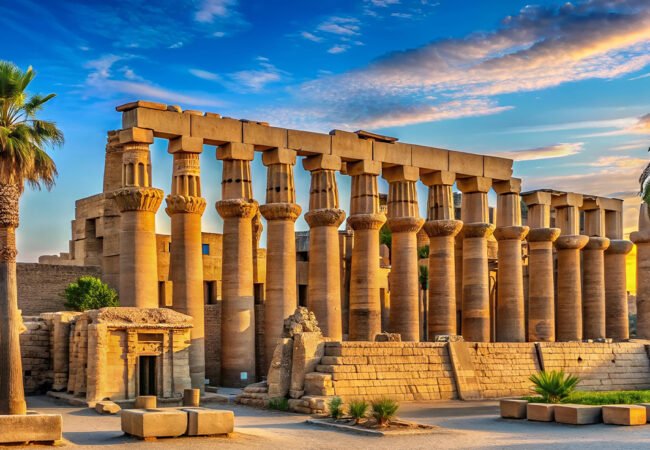Our Destinations
info@happypharaohtours.com
Luxor
- Home
- Luxor
Luxor: The World’s Greatest Open-Air Museum
Luxor, often referred to as the world’s greatest open-air museum, is a city that embodies the grandeur of ancient Egypt like no other. Situated on the east bank of the Nile River, Luxor stands on the site of the ancient city of Thebes, the glorious capital of the New Kingdom. With its colossal temples, sprawling tomb complexes, and captivating history, Luxor offers a journey back in time, where the echoes of the pharaohs still resonate.
The Splendor of Ancient Temples
Luxor is home to some of Egypt’s most iconic and well-preserved temples. The magnificent Karnak Temple Complex is the largest religious building ever constructed, dedicated to the Theban triad of Amun, Mut, and Khonsu. Walking through its vast hypostyle hall, with its towering columns and intricate carvings, is a truly awe-inspiring experience. At night, the Sound and Light Show brings the history of Karnak to life, offering a captivating storytelling experience.
Nearby, the Luxor Temple stands as a testament to the architectural prowess of the ancient Egyptians. Linked to Karnak by the Avenue of Sphinxes, this temple is especially stunning when illuminated at night, with its massive statues of Ramses II guarding the entrance.
The Valley of the Kings and Queens
On the west bank of the Nile, the arid cliffs and valleys hold the secrets of the afterlife. The Valley of the Kings is the final resting place of many New Kingdom pharaohs, including the famous tomb of Tutankhamun. Each tomb is a masterpiece, adorned with colorful wall paintings and hieroglyphs that depict the journey of the deceased through the underworld.
Nearby, the Valley of the Queens is equally impressive, with the tomb of Queen Nefertari being a highlight. Known as the “Sistine Chapel of Ancient Egypt,” Nefertari’s tomb is one of the most beautiful and well-preserved, showcasing exquisite paintings that have retained their vibrant colors for over 3,000 years.
The Majestic Colossi and Temples of the West Bank
The west bank of Luxor is also home to the imposing Colossi of Memnon, two massive stone statues of Amenhotep III that have stood guard for millennia. Not far from here, the Mortuary Temple of Hatshepsut is a stunning example of ancient Egyptian architecture. This terraced temple, nestled against the dramatic cliffs of Deir el-Bahari, is dedicated to one of Egypt’s most powerful and successful female pharaohs.
The Ramesseum, the mortuary temple of Ramses II, and the Temple of Medinet Habu, dedicated to Ramses III, are other must-visit sites on the west bank. These temples, though less visited, are rich in history and offer a quieter, more intimate exploration of ancient Egypt’s grandeur.
A Cultural Experience
Luxor is not just about ancient history; it is a city alive with culture. The bustling souks of Luxor are perfect for exploring local crafts, spices, and souvenirs. The Luxor Museum and the Mummification Museum provide deeper insights into the city’s ancient past, with well-curated exhibits that include royal mummies, statues, and artifacts.
A felucca ride on the Nile at sunset offers a peaceful way to experience the beauty of Luxor. As you sail along the gentle waters, you can see the city’s temples and tombs bathed in the golden light of the setting sun, a truly magical sight.
A Gateway to Ancient Wonders
Luxor is more than just a city; it is a gateway to the wonders of ancient Egypt. Whether you’re a history enthusiast, an archaeology lover, or a curious traveler, Luxor offers an unparalleled opportunity to walk in the footsteps of the pharaohs and explore the timeless treasures of one of the world’s oldest civilizations.
From the majestic temples of Karnak and Luxor to the sacred tombs in the Valley of the Kings and Queens, Luxor is a place where history comes alive and the legacy of ancient Egypt endures. It is a destination that promises to captivate, inspire, and leave you in awe of the incredible achievements of a civilization that has shaped human history for millennia.
Luxor
Arabic
Egyptian pound
Recommended Package
Starting From:
$75TAXES INCL/PERS
Starting From:
$55TAXES INCL/PERS
Starting From:
$65TAXES INCL/PERS
Starting From:
$185TAXES INCL/PERS
Starting From:
$395TAXES INCL/PERS
Starting From:
$140TAXES INCL/PERS
Starting From:
$45TAXES INCL/PERS
Starting From:
$105TAXES INCL/PERS
Starting From:
$100TAXES INCL/PERS
Join The Newsletter
To receive our best monthly deals
















